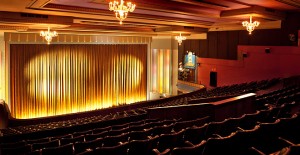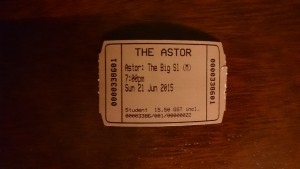
On Sunday I went to see “The Big Sleep” (Hawks, 1946) at the Astor theatre in St Kilda. This was a first for me in two regards, my first time seeing The Big Sleep and my first time seeing a film at the Astor theatre. For all the film aficionados in Melbourne, I know, I don’t know why it took me so long to go and see a film at this incredibly beautiful, restored, with all the old furnishings and old timey style intact, 1930’s, single-screen cinema.
Even the ticket stub looks authentic.
Ish.
Waiting inside for my friend to show up on the trademark bouncy couches of the era was like stepping into the 30’s in surprising comfort.
Now to the film.
The Big Sleep is a film adapted from the 1939 novel of the same name written by none other than Raymond Chandler. That’s right kids, the man who practically fathered the genre (or at least the classic, convention-filled, hard-boiled detective and femme fatale centric story line film noir that we’ve all come to know and love). The Big Sleep itself features such classic conventions as the hard-boiled detective, namely the original archetype found in Phillip Marlowe, the femme fatale or in this case Vivian Rutledge, an almost literary dialogue, expressionistic lighting and weather and the girls falling for Marlowe as far as they can possibly throw themselves.
While this film does contain many of the qualities that make it an almost nostalgic film noir, as it ticks all the ‘conventional’ boxes, it is however formulaic and fits the category of being a film that seems to simply want to get in on the movement sweeping the era, rather than create something unique and interesting within the genre, such as “Double Indemnity” (1944, Wilder), a film written by Raymond Chandler, which came out two years prior. The editing and staging, and therefore direction is also poor in some areas. I personally don’t know if this is exemplary of the era and the level of the equipment being used, but I feel like other film noirs did these things better, as there was no visible lag and displacement between some of the cuts, which in The Big Sleep actually creates a sort of ‘forceful ejection’ of the audience as they are forced out of the world in which they were previously consumed.
Also, the plot is at times difficult to follow. It honestly just jumps around too much between different people of interest. At one point when there is a big reveal, the sound level suddenly drops for no apparent reason other than possibly the technology at the time (which is just really bad luck) and I actually didn’t know what the big shocking reveal was at first. I can’t help but wonder if it was because I was viewing it in a cinema on old celluloid film, or whether it was actually the production and processes used during the production itself.
Enough of the black hat, let’s move on to the good, juicy stuff.
One thing I’ve always loved about film noirs, and which was very evident throughout The Big Sleep, is the use of stark chiaroscuro lighting in an expressionistic way, that is to say lighting in a film noir is never usually realistic but almost always amplifies what is occurring in the film, both in terms of action and emotion. In The Big Sleep though this was taken to another level, as not only the lighting was stark and expressionistic, but so too was the weather. As the mood became gloomier and gloomier, the weather began to mimic it as it suddenly went from sunny in one outdoor scene to raining in another. The best uses of this technique were during a sudden plot development, lighting strikes and bars are created through the Venetian blinds (personally my favourite lighting trick in film noir is the use of shadows, particularly when Venetian blinds are involved).
The whole last section of the film takes place in fog which creates the most suitable metaphorical weather conditions while also creating some of the best lighting effects I’ve seen in a film noir, or any film for that matter. Much of the lighting in film noirs is used to emphasise a characters development, and in this case emphasises Marlowe’s internal struggle with the case, and shows his development morally as a character, the fog in particular giving the idea of confusion and setting up the atmosphere for the upcoming hectic scenes.
Another thing I really love about the film noir genre, especially films adapted from/written by Raymond Chandler, is that the script, mainly the dialogue has a very literary feel to it. It’s a constant eb and flow, a dance between the characters in such a poetic way. Ask yourself, ‘would I ever say this in reality?’. With pretty much all film noirs that have this literary feel, the answer is clearly no, as they feel more like your listening to the sweet words of two poets battling than two characters on screen. Chandler tends to have this flowing effect with his writing and this was clearly transferred to the adaptation.
The dialogue is also, when viewed today, very forward and sexist and like a game of cat and mouse, Marlowe being the cat and Vivian being the mouse. In the context of the times such a male fantasy, being surrounded by beautiful women throwing themselves at you only to find a woman more beautiful and seemingly impossible to attract (the femme fatale) is very common of this era and explains the heavy use of filming techniques that linger on the female form and create a ‘male gaze’.
While such male-centric techniques were common during the 40’s, 50’s and 60’s it’s unfortunate to see that such techniques are still heavily used today in film, despite the fact that they often do not contribute to the overall film in anything but style and alienate around half the audience, as nowadays women are just as likely to enjoy action films and other such male-centric genres as men.
The Big Sleep is a classic, classic film noir, following all of the conventions we’ve come to both love and hate of the genre to the point where this could even be called a mainstream film by the standards of the era. Like many blockbusters that are distributed around the world today, this film may have been more concerned with mooching money off of the film noir movement than creating a traceable and understandable plot. That being said, this film does create some worthwhile scenes using expressionistic lighting and circumstance emphasising the best parts of the genre. I guess we’ve just got to take the bad with the good.
Watching this film at an old theatre like the Astor and seeing the final shot wrap up with the red curtain being drawn over the top of it to reveal the ending title card somehow seemed more fulfilling than simply watching this film, or any other film like it, at home. A beautiful, old theatre like the Astor, that somehow seems to have some renewed vigor imbued within it, is definitely the way to watch any classic film.




